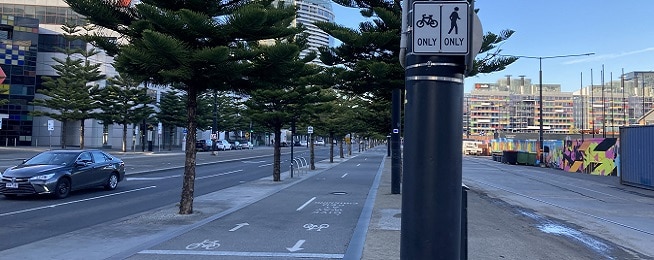A new set of draft Tasmanian Planning Policies have been released for public comment, outlining an improved approach to supporting bike riding in new developments.
There is a lot going on in planning reform at the moment.
The Tasmanian Planning Policies are a new set of policies that sit above the State Planning Provisions, which are also being reviewed.
The Tasmanian Planning Policies seek to provide an overall direction by outlining the aims and principles for the planning scheme, while the State Planning Provisions contain the actions and detail to implement the goas. This is what developers have to tick off to get planning approval.
First round of consultation
A scoping paper and example Tasmanian Planning Policies were released last year for the first round of public comment.
Bicycle Network made a submission suggesting that a dedicated transport and mobility policy was needed, rather than spreading transport out over more than one policy as had been done in the example policies.
The submission also outlined the need to stop prioritising private car use over other transport modes and to recognise the many benefits of facilitating cycling, walking and public transport.
New draft policies
This next stage of consultation includes the detailed draft policies and supporting report.
There are 7 draft policies, with cycling infrastructure sitting in the Physical Infrastructure policy and Settlement policy.
Both draft policies provide the guidance to get the modal shift we need towards active and public transport. But the devil is in the detail, which is why the review of the State Planning Provisions is also important as these detail the ways in which the Tasmanian Policies could be implemented.
You can make a submission on the policies via the contact details at the end of this article. Bicycle Network will be making a submission but the more the merrier so the government understands there is support for changes to the way we plan our urban centres so it’s easier to ride a bicycle for transport.
Settlement Policy
The Settlement Policy is split into 6 different areas.
Under 1.1 Growth, the policy requires:
- structure plans to consider “movement networks, including street hierarchy and pedestrian and cycling paths for active transport modes” (1.1.3-6c).
- “Encourage the concentration of commercial, administrative, major retail, entertainment and cultural use and development within activity centres that are highly accessible by public and active transport” (1.1.10).
Under 1.2 Liveability, the policy requires:
- “Provide for connectivity within settlements, especially between residential areas, activity centres and open space networks, through a network of legible and accessible infrastructure dedicated to active transport modes, including end of trip facilities.” (1.2.3-5).
- “Provide integrated transport networks that allow people to move safely and efficiently between and within settlements utilising different transport modes, including public transport, cycling and walking, to reduce car dependency.” (1.2.3-6).
Under 1.3 Social Infrastructure, the policy requires:
- “Integrate public and active transport networks with major social infrastructure” (1.3.3-4).
Under 1.5 Housing, the policy requires:
- “Encourage higher density housing in locations that: have good access to employment, services, open space and active and public transport networks” (1.5.3-5c).
Under 1.6 Design, the policy requires:
- “Encourage the design and siting of buildings to positively contribute to: safe access and egress for pedestrian, cyclists and vehicles.” (1.6.3-1f).
- “Encourage public places that are designed to promote: integrate land use and transport; and encourage active transport through the provision of safe and shaded rest areas with urban furniture, drinking fountains and similar amenity measures.”(1.6.3-6d, 6e).
- “Promote subdivision design that considers the existing and future surrounding pattern of development and provides for connection and integration of street networks, pedestrian and bicycle paths and the efficient provision of services.” (1.6.3-7).
- “Promote subdivision design that provides a functional lot layout that: provides safe active transport” (1.6.3-8g).
Physical Infrastructure Policy
The Physical Infrastructure Policy contains two sections dealing with transport modes and roads, and specifically states in its climate change statement:
“The Physical Infrastructure TPP supports the provision of well-planned and well-designed infrastructure that can reduce emissions and take advantage of emerging opportunities in a low emissions future by: better sharing of road space to support increased uptake of more sustainable transport modes.”
Under 5.3 Roads, the policy requires:
- “Provide for new and upgraded road infrastructure on key urban and local corridors to allocate space for electricity infrastructure, public transport, walking and cycling modes.” (5.3.3-5)
Under 5.4 Transport Modes, the policy requires:
- “Provide an active transport network within key urban areas that is integrated across State and local government networks, and which includes dedicated infrastructure, appropriate signage, and end of trip facilities.(5.4.3-5)
- “Encourage public transport corridors to be supported by active transport networks and bus stops that are safe, accessible and provide for better passenger amenity.” (5.4.3-6)
- “Provide for subdivision design that: encourages walking and cycling, with the provision of appropriate and direct site-through links” (5.4.3-7b)
- “Recognise carparking as a key travel demand management measure, and appropriately manage carparking provision to support a modal shift” (5.4.3-11).
Make a submission
Your submission does not need to be long, you can simply say you support the policies’ treatment of active transport and why. Email your submission by Tuesday 1 November 2022 to yoursay.planning@dpac.tas.gov.au
More information at: https://planningreform.tas.gov.au/planning-reforms-and-reviews/tasmanian-planning-policies


